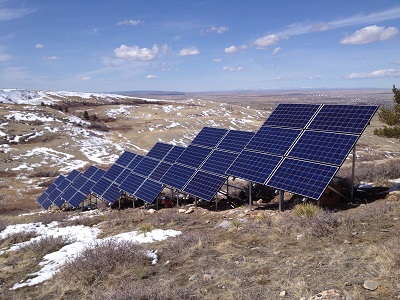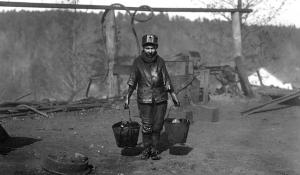
In the past two years President Trump has been in office, he’s been rolling back environmental regulations he says will revive the coal industry and has bragged about putting coal miners back to work.
But in reality, coal jobs are at a record low—just over 80,000 people are currently employed across the industry, and overall coal production has dropped to the lowest level in 40 years. The fact is that the shrinking fossil fuels industry from West Virginia to Wyoming has left thousands unemployed. Where the president says he’s putting people back to work, he could be working on creating a smooth fossil fuel to renewables transition.
As the clean energy industry has boomed to over 3.2 million jobs nationwide, advocates are just beginning to get a foothold in rural America. Nonprofits and people-minded businesses are fueling the clean energy transition and showing folks that clean energy can bring jobs and other economic gains.
The State of Mind
Brandon Dennison is a resident of Huntington, West Virginia, nestled between the borders of Ohio and Kentucky. In 2009, he was working on the construction of a house as a volunteer, when two men with tool belts approached, asking if there was work for them. They walked away when they found out it was a group of volunteers. The moment stuck with Dennison.
He saw that there were young people looking for good jobs—the kind of people who would be working in the coal mining industry if that wasn’t declining. Instead, they were getting jobs at fast food chains and box stores if they found them at all.
Dennison got the idea to train the state’s unemployed young adults who were struggling with generational poverty and what Dennison calls a “pervasive pessimism” from seeing their parents put out of work by the dying coal industry.
“I feel like a lot of the problem in Appalachia was that our economy was so based in extractive industries and that’s what got us to the stressed situation we’re in economically, socially, and environmentally,” Dennison says. “We’re trying to model what a new and better and more sustainable economy could look like. There’s a social and environmental angle. I also think there are real business opportunities in the green economy, and so we’re trying to seize on those.”
Dennison originally called his nonprofit the Green Collar Jobs Initiative, but he found that folks weren’t convinced by the name.
“[In Appalachia,] there’s a skepticism and reticence with anything green. There’s a perception that it’s going to be unicorns and rainbows and fluffy fluff,” Dennison says, chuckling. “And, getting things moving again can be a heavy lift. It can be harder to propose new ideas here than in places where the economy is more vibrant, where there’s more money flowing and more optimism.”
Building a Workforce
In the years since he started his nonprofit, Dennison changed the name from Green Collar Jobs Initiative to Coalfield Development. It is succeeding in attracting students out of vocational high schools, unemployment offices, local Department of Health and Human Services offices, and Temporary Assistance for Needy Families offices. The organization includes five social enterprises, which teach job skills in solar energy; green construction; food and farming; rehabilitating mining sites, like mountaintop removal; and artisan skills.
Coalfield Development designed its programs to address a concern from local workers that certifications weren’t enough—young workers wanted experience in their desired fields, not just classroom time. Dennison notes that a person can’t apply for unemployment unless they can prove they lost their job. These young people were stuck in a cycle—they couldn’t find jobs to get experience and to get paid, couldn’t find money to get training without having a job. Dennison wanted to help get people out of the rut for the long term.
Crew members at Coalfield Development participate in its “33-6-3 program.” After signing onto a 30-month contract to be part of Coalfield’s crew, a crew member works for pay 33 hours per week in their enterprise of choice—like working on a farm, installing solar panels, or rehabbing old buildings. He or she also does six hours of college classes to create a modern, skilled workforce.
“Once we got started, we realized that a lot of the challenges that were tripping up our crew members were ‘life stuff’: health problems, mental and emotional health issues, transportation barriers, financial management breakdowns,” Dennison says. “And a pervasive pessimism that can put people in a really tough mindset to learn and grow.”
So the program added on three hours per week of personal reflection and growth sessions—which Dennison says is both the hardest and the most transformative.
When they’re done, crew members have over two years of job experience, an associate’s degree from a community college, and the personal skills they need to manage their adult lives.
The program has been extremely successful since its start in 2010. As of April 2019, Coalfield Development has trained over 850 crew members, created over 190 new jobs, placed 95 alumni in full-time careers, been a part of starting 40 new businesses, and redeveloped 187,000 square feet of formerly vacant property.
Coalfield isn’t just growing for the sake of it—the demand for skilled green workers is there, even in West Virginia.
Finding Meaningful Work
A few hundred miles north and west of Huntington, a business called Solar Holler started putting solar panels on the Presbyterian church in Shepherdstown, West Virginia. Despite the church’s financial struggles, the company’s owner, Dan Conant, figured out a creative way to fund the church’s installation, and planned to do more of the same so he could bring down utility costs for nonprofit organizations that were doing so much good in their communities.
But with that first project, Conant immediately saw the limit of the folks who knew how to install solar panels in the area—he’d already hired them. He knew they had to find more workers.
So he called Brandon Dennison, and Solar Holler started sponsoring Coalfield Development’s program “Rewire Appalachia.” Eventually, it just made sense for Solar Holler buy the whole program off of Coalfield Development and continue the 33-6-3 model to develop its own workers.
“That partnership was a way to build up folks to meet the demand in the state. But it was also a way to put our labor dollars back into communities where that was needed and powerful,” Connant says. “The program gave folks that we were working with a chance to stay at home and not have to leave the state to get a job.”
Getting Communities on Board
Steve Lieske has been running Harmony Solar as a side gig in Laramie,Wyoming for 12 years. He and his clients have a lot in common—he’s not in the solar business for the money, and they’re not expecting to get save much money, either. Lieske says his clients are mostly close to or in retirement, have a bit to spend, and are interested in leaving a positive legacy.
The Solar Energy Industries Association (SEIA), a solar energy trade group, ranked Wyoming last in solar jobs—meaning there were fewer solar jobs there than any other state—with a mere 190 employed. The state gets only .02 percent of its energy from the sun, despite being ranked eighth for solar capacity by SEIA, meaning direct sunlight is plentiful and precipitation rare.
Lieske explains that the hesitancy to move towards clean energy is because of the state’s historical reliance on fossil fuels. Wyoming supplies about 40 percent of the nation’s coal and produces about two percent of the country’s crude oil.

“The problem is that renewable energy in a place like Wyoming has always been a culture war. This state has been supported by coal, oil, and gas since the beginning of the modern era,” Lieske says. “They’re the reason we have good times when we do have good times, they’re the reason we have bad times when we’re in the middle of a bust. People have a profound emotional connection to coal, oil, and gas in this state, and they see renewables as a threat.”
Because of its ties to the coal, oil, and gas industries, Wyoming’s legislators have done little to incentivize solar. Without tax credits or any state-wide incentives, solar installations remain quite expensive. Lieske says when something takes 12 years to pay for itself (partly because of extremely cheap electricity from coal in the state), it makes it a much harder sell. In the 12 years he’s been running Harmony Solar, he’s done only about five or six installations per year. But times are changing.
How Scaling Up Changes Minds
Wyoming’s first utility-scale solar project was built last fall. It creates 80 MW of energy, enough to power 12,000 homes. It’s not a lot, compared to say, California, which recently hit a new record of producing over 11,000 MW of solar. But there has to be a first project for there to be a second, and a third.
Kelley Welf works at Clean Grid Alliance, a nonprofit that educates and builds support for clean energy projects, like utility-scale solar and wind projects in nine Midwest states (not including Wyoming). Welf explains that it can be tricky to get a large clean energy project built in any community. Usually, solar or wind companies do their own research to find well-suited areas before approaching a town or county to start the project. But, plans can be delayed or halted by groups fighting against clean energy progress, because they think the array will be ugly, think they will have negative health effects, or generally are afraid of the unknown.
Though cities are more likely to have broad support for clean energy, rural communities are most likely to become home to these projects, because of the needed acreage.
Clean Grid Alliance’s website has resources for folks in rural communities whose towns have been sited for a clean energy projects. Trump administration officials argue that we need fossil fuels to have a strong economy. But that isn’t true. Since 2009, solar prices have dropped by 88 percent and wind prices fallen by 69 percent. Clean energy projects continue to cost less and fuel the economy more.
Welf explains the boom that happens when crews come to do a massive installation. Local businesses from hotels to hardware stores benefit not just during the install—often companies will set up offices with a few workers to manage the site. Projects also generate local tax dollars which pay workers like teachers and firefighters. Warehousing and manufacturing create jobs in other locales.
Wyoming may already be feeling a sea change. Lieske is already booked for 12 consultations this spring—and it’s not quite building season yet, with snow still falling in Laramie in late May.
But remember, Wyoming is a clean energy laggard, and large-scale projects can have an outsized impact. Indiana utility NIPSCO has been running on 65 percent coal energy, but recently decided to make the switch to 100 percent renewables in the next decade. Corporate purchases of renewables rose to 8.5 gigawats in 2018, equivalent to the capacity of all utility-owned renewables in the US. That growth is partly because of major purchases from AT&T, T-Mobile, and Amazon, all of which have been recent targets of clean energy campaigns by Green America.
“The solar business has been a bit of a sideline job for twelve years now,” Lieske says. “Our hope is for all [three] of us to be able to drop our day jobs to be able to do this full time.”







